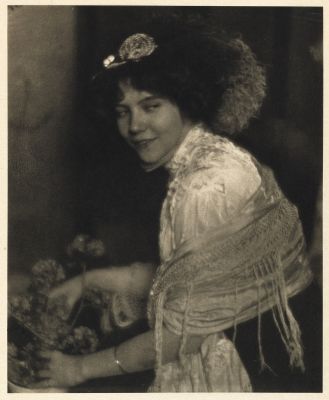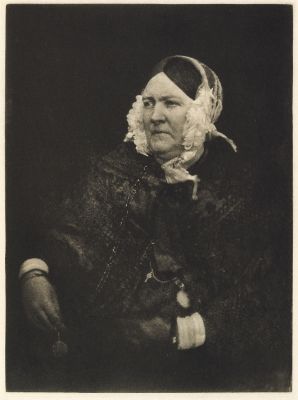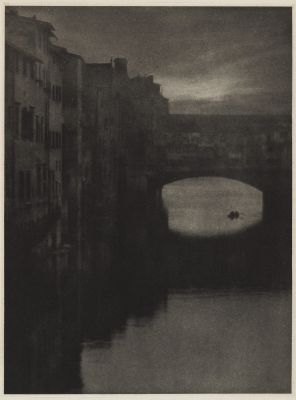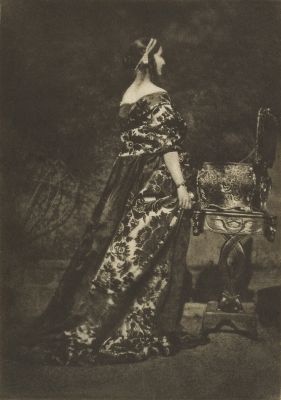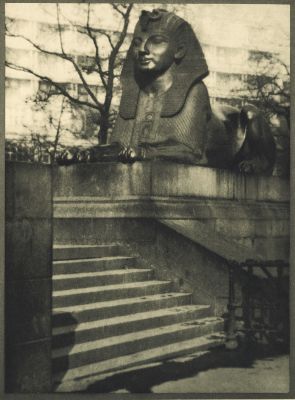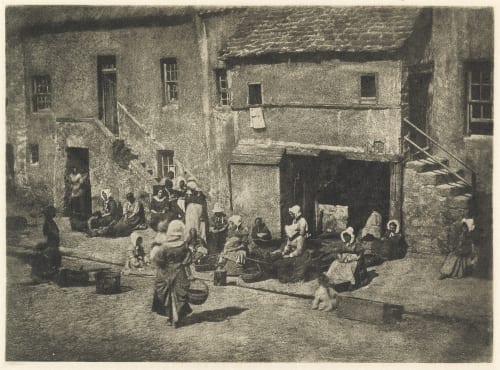
Title
Newhaven FisheriesArtists
Hill, David Octavious (Scottish, 1802-1870)Adamson, Robert (Scottish, 1821-1848)Publication
Camera Work XXVIIIDate
1890 plate (1843-1847 negative, 1909 print)Process
PhotogravureAtelier
T. & R. Annan & SonsImage Size
13.9 x 19.3 cm
"The fact that it looks spontaneous is extraordinary." Sara Stevenson
For all its spontaneity and apparent objectivity, this work is highly controlled. The figure of the woman striding across the cobblestone road suggests that a moment in time has been captured, but because any movement would have rendered her a blur, she must be standing still, holding her position (as well as her basket and child). This was quite an accomplishment, considering that the exposure time may have ranged from thirty seconds to a couple of minutes. You can’t underscore enough how unusual that element is in the photographs not just of this time but even of twenty years later. It was extremely difficult to get that dynamic, animated quality that Hill and Adamson have achieved. A variant of the plate presents a somewhat different arrangement but the same woman is still crossing the street, suggesting that Hill and Adamson made multiple exposures to test various visual ideas. [1]
Photography was essentially an invention of the Industrial Revolution. By the 1840s, the adverse social and economic impact of that revolution had become painfully clear – the economic booms were followed by severe slumps; the astonishing advance and increased wealth of the nation were imbalanced by periodic destitution, by endemic disease and high mortality. The cities were crowded by incomers looking for work, and the centers of the cities were overtaken by slums. Journalists and other deeply concerned writers attempted to analyze and answer these problems. The first photographic essay addressing such issues in Scottish photography looked at a model of excellence – a cultured and self-determining working community – rather than at the disaster of the slums. In 1844, D. O. Hill and Robert Adamson advertised an album on The Fishermen and Women of the Firth of Forth. They took around 130 photographs, principally on site in the fishing village of Newhaven, a mile to the north of Edinburgh, but also on the other side of the estuary in St Andrews. The pictures show empathy between the photographers and their subjects, based on admiration for working life. With this series, Hill and Adamson invented social documentary photography, many decades before it became a practical proposition in the photographically illustrated magazines. [2]
Reproduced / Exhibited
Kruse, Margret. Kunstphotographie Um 1900: D. Sammlung Ernst Juhl; Hamburg: Museum für Kunst u. Gewerbe, 1989 pl. 491
Schwarz, Heinrich. David Octavius Hill, Master of Photography: With 80 Reproductions Made from Original Photos and Printed in Germany. London: G.G. Harrap, 1932. pl. 27
Stevenson, Sara, and Alison Morrison-Low. Light from the Dark Room: A Celebration of Scottish Photography : a Scottish-Canadian Collaboration. Edinburgh: National Galleries of Scotland, 1995. pl. 107 (salt print)
References
[1] J. Paul Getty Museum. In Focus : Hill and Adamson. J. Paul Getty Museum 1999.
[2] Stevenson, Sara, and A D. Morrison-Low. Scottish Photography: The First Thirty Years. , 2015. Print. P.203
